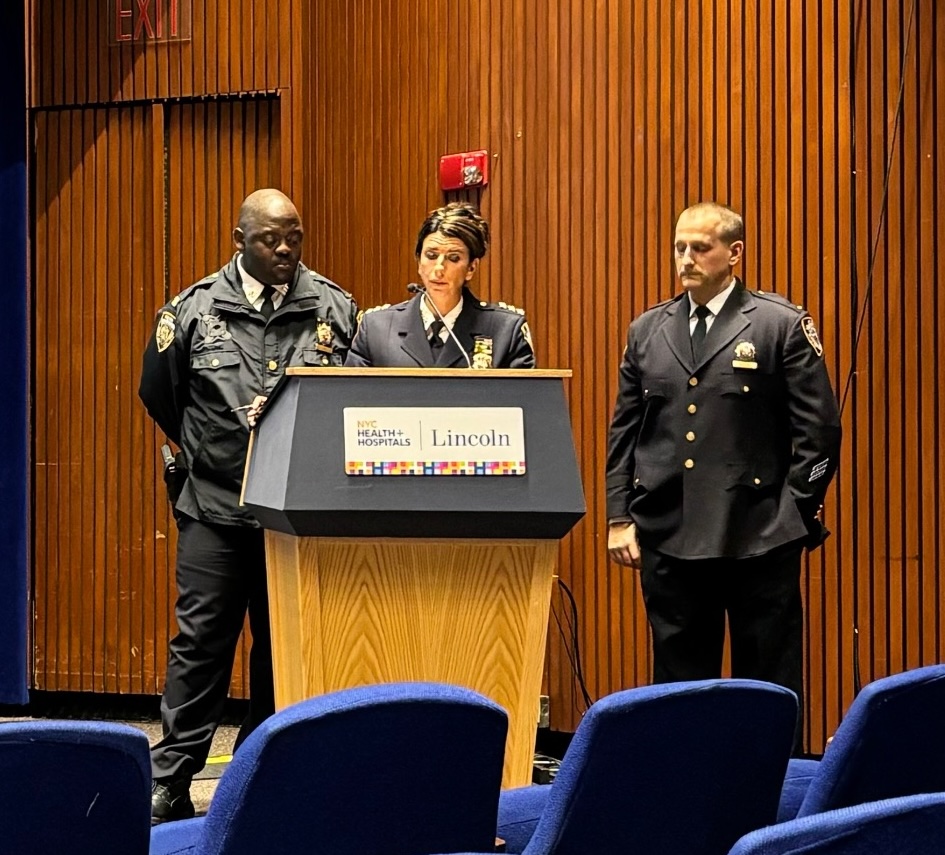New committee focused on improving conditions in public housing developments
At Community Board 1’s first hearing Monday for its newly-formed Public and Supportive Housing Committee, most of the focus was on people who occupy public housing apartments illegally.
A dozen or so police officers – including NYPD Housing Bureau Chief Martine Materasso – met with the board and other community members in the Lincoln Hospital auditorium, to discuss a new initiative to remove unauthorized dwellers from NYCHA apartments.
NYPD Lt. Alex Baran led the presentation inside the large, dimly-lit conference room at Lincoln Hospital. He works within the Housing Bureau Reclamation Unit, which has removed illegal occupants from 46 apartments since April 2023.
The unit plans to expand to the Bronx this year, he said.
NYCHA has struggled in recent years with illegal dwellers who break the locks of recently-vacated units and take up residence, or use the unit for illicit activities. Removing unauthorized occupants can be a time-consuming process in a city experiencing record-levels of homelessness, according to Baran.
Police Service Area 7 Captain Emmanuel Kwo, whose team covers public housing in the 40th and 42nd precincts – which serve Melrose, Mott Haven, Port Morris, Claremont, Crotona Park East and Crotona Park – said staffing shortages prevented the reclamation unit from getting to the Bronx earlier.
Baran and one other police officer are the sole investigators within the reclamation unit.
The reclamation unit’s work addresses safety concerns as well as the city’s ongoing housing crisis, Baran said. There are 5,023 vacancies across all NYCHA developments, and the presence of an unlawful tenant in an apartment delays the time it takes to prep the space for new, legal residents.
“It’s not the answer, right?” he said in reference to the city’s overwhelming need for more housing. “It’s not gonna solve the [issue of] 100,000 people who need housing, but it’ll be a few thousand less and for those few thousand people, that’s gonna mean a lot.”
Baran said it is difficult to know how many people trespass in and out of public housing units. It’s easy to do, police and committee attendees agreed, in part because of the flimsy locks NYCHA attaches to the doors of vacated apartments.
Several people who attended the Public Housing/Supportive Housing Committee meeting live in public housing developments in the South Bronx. They expressed their familiarity – and frustration – with the issue.
“In some buildings, I have tenant patrol, but there’s elderly people that’s doing the patrol,” said Patricia Simpson, president of the resident association in the Patterson Houses in Mott Haven.
“We’re out there in the buildings, but as soon as we close up, these people come back in,” she said.
Trespassers leave needles scattered around inside the buildings, and they relieve themselves in the public spaces, Simpson and other attendees said.
A majority of the people who unlawfully occupy the apartments use them to carry out illegal activities, like using illicit drugs or hoarding stolen goods, the police said.
The police issue the person a summons in lieu of an arrest if their investigation concludes that an unauthorized occupant is unhoused.
The police were also peppered with questions about security issues that are under NYCHA control, such as camera surveillance and properly-maintained front door locks.
Committee Member and Mitchel Houses resident Ramona Ferreyra voiced her frustration with NYCHA’s handling of tenants’ complaints.
“In our community, because we’ve been living in deficit for so long, we’re constantly told ‘Go speak to someone. Oh, go talk to this person, develop a relationship with that person,’” she said. “I’m not about relationships.”
The Housing Authority did not immediately respond to a request for comment.

